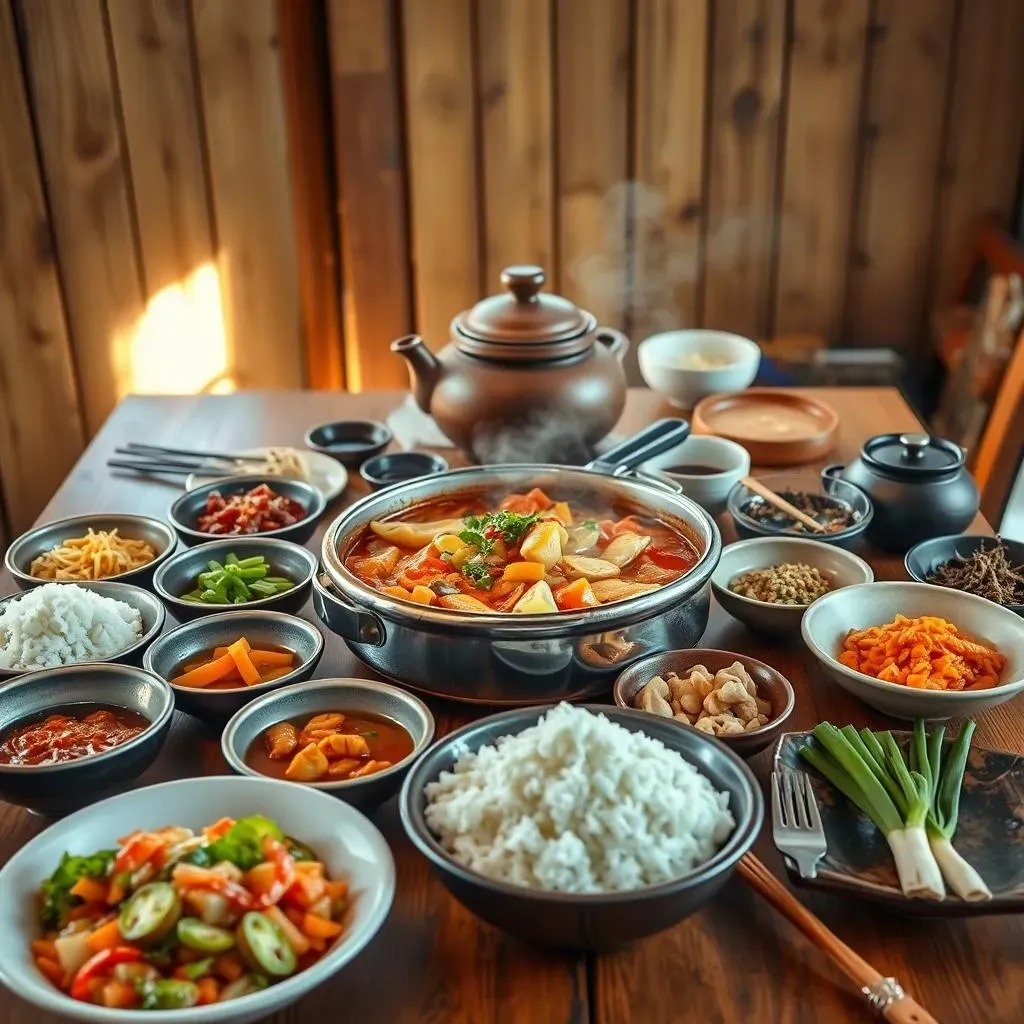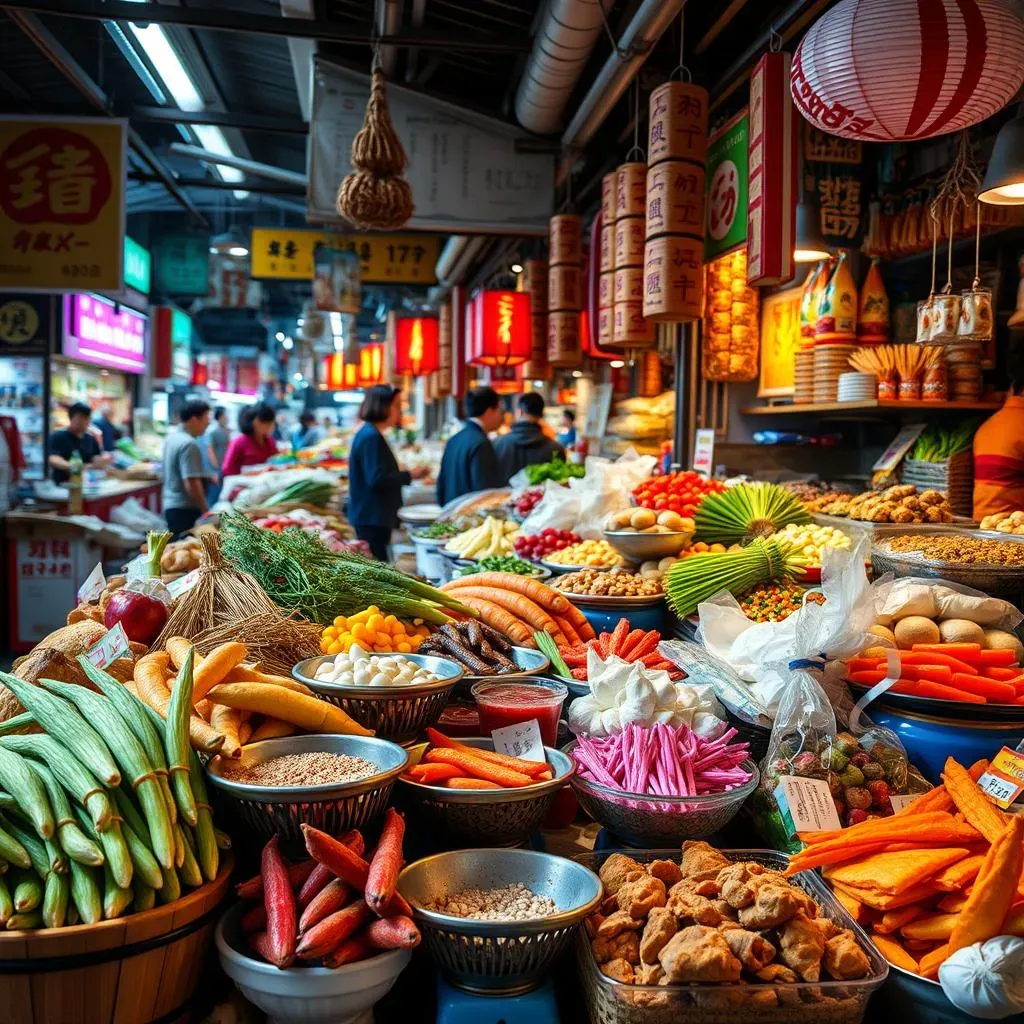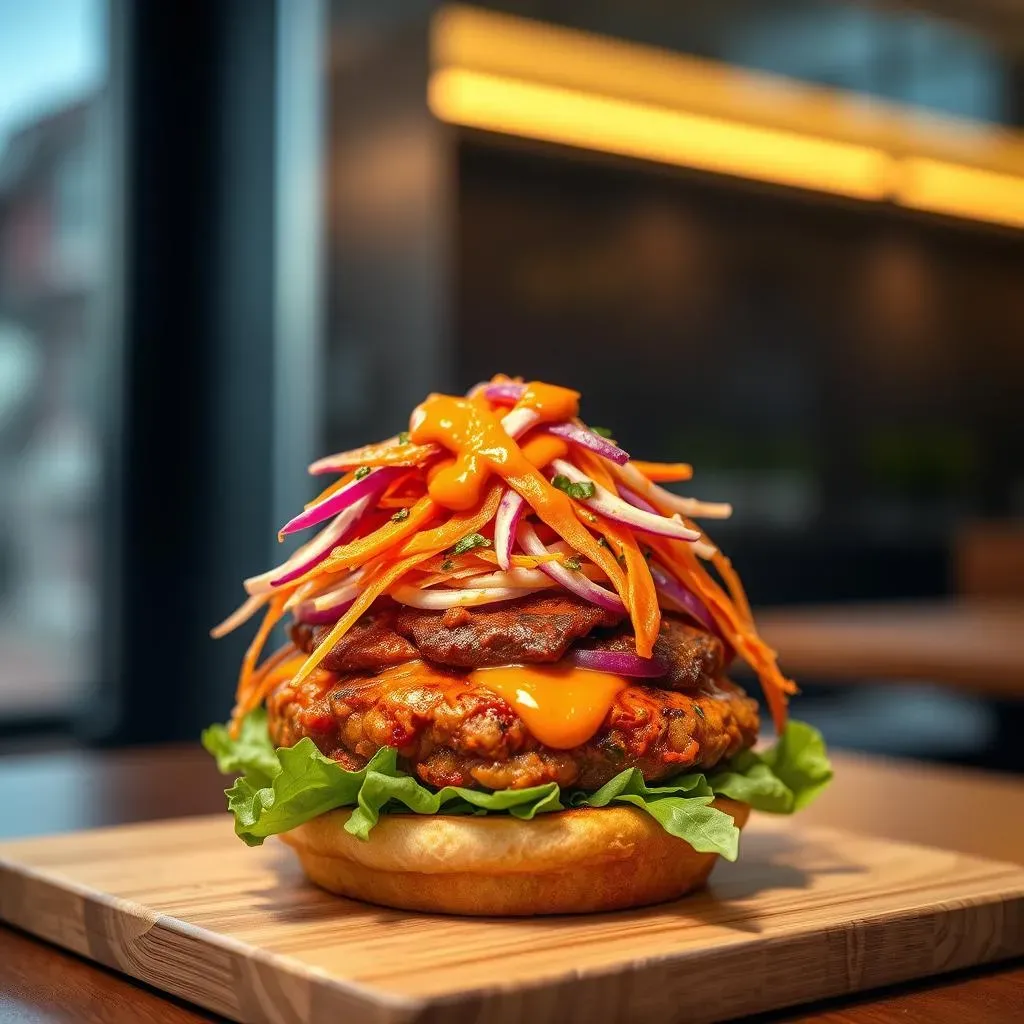Table of Contents
Get ready for a culinary adventure! This article is your passport to the exciting world of K-food: Korean home cooking and street food. We'll journey through the comforting heart of Korean home cooking, exploring classic dishes passed down through generations. Imagine the rich aromas of simmering stews and the vibrant colors of perfectly arranged banchan (side dishes). Then, we'll hit the streets, experiencing the electrifying energy of Korean street food markets. Picture sizzling bulgogi, savory pancakes, and sweet treats that will tantalize your taste buds. But our exploration doesn't stop there. We'll uncover some unexpected Korean flavors, going beyond the well-known kimchi, and discover how modern chefs are putting creative twists on these timeless recipes. So, whether you're a seasoned foodie or a curious beginner, prepare to be amazed by the diversity and deliciousness of Korean cuisine. Let's embark on this flavorful journey together!
The Heart of the Home: Exploring Traditional Korean Cooking
The Heart of the Home: Exploring Traditional Korean Cooking
The Essence of Banchan: A Symphony of Flavors
Korean home cooking isn't just about the main dish; it's about the incredible array of banchan, the small side dishes that accompany every meal. Think of it as a culinary orchestra, where each banchan plays its part, creating a harmonious blend of textures and tastes. You might find kimchi, of course – that spicy fermented cabbage that's a Korean staple – but also vibrant spinach seasoned with garlic, savory seasoned bean sprouts, and perhaps some seasoned seaweed. The variety is endless, and each family has its own unique collection of recipes passed down through generations. Learning about banchan is key to understanding the heart of Korean home cooking.
One of the beautiful things about banchan is its versatility. Some are simple, like seasoned spinach, requiring minimal ingredients and preparation. Others, like kimchi, are more complex, involving fermentation processes that take time and skill. This diversity reflects the resourcefulness and creativity of Korean home cooks, who have always made the most of what's available. Check out this guide to authentic Korean street food for more inspiration!
Banchan Type | Main Ingredients | Flavor Profile |
|---|---|---|
Kimchi | Cabbage, Gochugaru (Korean chili powder), Garlic, Ginger | Spicy, Fermented, Tangy |
Kongnamul Muchim (Bean Sprout Salad) | Bean Sprouts, Sesame Oil, Soy Sauce, Garlic | Savory, Slightly Sweet |
Sigeumchi Namul (Seasoned Spinach) | Spinach, Sesame Oil, Garlic, Soy Sauce | Savory, Slightly Bitter |
From Rice to Stew: The Foundation of Korean Meals
At the heart of most Korean meals lies steamed rice, a fluffy, comforting base that complements the various side dishes and main courses. It's not just a filler; it's an integral part of the dining experience. Often, you'll find it served alongside a hearty stew like jjigae, a bubbling pot of flavor that can range from spicy kimchi jjigae to a milder, comforting soybean paste stew (doenjang jjigae). These stews are often packed with vegetables, tofu, and sometimes meat, creating a complete and satisfying meal. They're like a warm hug on a cold day – simple but deeply satisfying.
The preparation of rice and stews often involves techniques passed down through generations, from the careful selection of ingredients to the precise timing needed to achieve the perfect texture and flavor. This attention to detail is what elevates Korean home cooking to an art form. For example, the perfect texture of the rice is crucial, it should be fluffy but not sticky. And the stew's flavor should be balanced, not too salty or too spicy. See some examples of popular Korean street food to see how these flavors translate to quicker dishes.
- Steamed Rice
- Kimchi Jjigae (Kimchi Stew)
- Doenjang Jjigae (Soybean Paste Stew)
- Bibimbap (Mixed Rice with Meat and Vegetables)
Beyond the Basics: Exploring Regional Variations
While certain dishes are common throughout Korea, regional variations add exciting layers of complexity and diversity to the culinary landscape. For instance, the spiciness of kimchi can vary significantly from region to region, reflecting the local preferences and the availability of different chili peppers. Similarly, the main ingredients and cooking methods used in stews can also differ, leading to unique flavor profiles. Exploring these regional variations is a rewarding journey of discovery, allowing you to appreciate the richness and depth of Korean home cooking.
Imagine the subtle sweetness of seafood stews found in coastal regions, contrasting with the bolder, more savory flavors of stews found inland. Each region has its own unique culinary heritage, shaped by its geography, climate, and cultural traditions. This is a testament to the creativity and adaptability of Korean home cooks, who have always found ways to make the most of their local ingredients. Want to learn how to make some of these dishes yourself? Check out our guide on how to make Korean street food!
From Street to Plate: The Thriving World of Korean Street Food
From Street to Plate: The Thriving World of Korean Street Food
A Sensory Explosion: The Street Food Experience
Stepping into a Korean street food market is like stepping into a vibrant, bustling carnival of flavors. The air crackles with energy, a symphony of sizzling sounds and tantalizing aromas. Vendors hawk their wares with infectious enthusiasm, their brightly colored stalls overflowing with tempting treats. It’s a feast for the senses, a thrilling experience that's as much about the atmosphere as it is about the food itself. You'll find everything from savory pancakes to sweet rice cakes, each bite a tiny adventure.
One of the things that makes Korean street food so special is its incredible diversity. There are regional variations, of course, but even within a single market, you'll find a dazzling array of options, from classic dishes to modern creations. It’s a culinary melting pot, a place where tradition meets innovation. This incredible variety reflects the creativity and resourcefulness of Korean street food vendors, who are always experimenting with new flavors and combinations. Want to know more about the variety of foods available? Check out this guide to famous Korean street food!
- Tteokbokki (Spicy Rice Cakes)
- Hotteok (Sweet Pancakes)
- Kimbap (Seaweed Rice Rolls)
- Odeng (Fish Cakes)
Beyond the Familiar: Discovering Hidden Gems
While some Korean street food dishes are internationally known, like tteokbokki, many hidden gems await discovery. These are the dishes that haven’t quite made it to the global stage, the culinary secrets whispered from one generation to the next. These might be regional specialties, unique to a particular city or town, or family recipes passed down through generations of street vendors. Seeking out these hidden gems is a rewarding experience, a chance to connect with the true heart of Korean street food culture.
The beauty of these lesser-known dishes lies in their simplicity and authenticity. They often feature fresh, seasonal ingredients, prepared with traditional techniques. These dishes are a reminder that Korean street food is more than just a quick snack; it's a reflection of Korea's rich culinary heritage. For example, you might stumble upon a stall selling a unique type of seasoned rice cake, or a vendor specializing in a particular kind of savory pancake. Each discovery is a small victory, a testament to the adventurous spirit of those who seek out the extraordinary in the ordinary. Looking for more hidden gems? Check out our post on Seoul's best street food secrets!
Dish | Description | Region (Example) |
|---|---|---|
Bungeoppang (Fish-shaped Pastry) | Sweet red bean paste-filled pastry | Nationwide |
Dakkochi (Grilled Chicken Skewers) | Spicy and savory grilled chicken skewers | Various |
More Than Just Food: The Social Aspect of Street Food
Korean street food is more than just about the food; it's about the social experience. Street food markets are vibrant hubs of social activity, places where people gather to eat, drink, and socialize. The atmosphere is lively and convivial, a blend of laughter, chatter, and the tantalizing aroma of delicious food. It’s a place where you can connect with locals, share a meal, and experience Korean culture in a truly authentic way. It's a community gathering, a place to share stories and make memories.
The simple act of sharing a plate of tteokbokki with friends, or grabbing a hotteok with a loved one, creates a sense of camaraderie and connection. These shared moments, fueled by delicious food, are what make the Korean street food experience so memorable. Whether you're a solo traveler or part of a group, you're sure to find yourself drawn into the lively atmosphere and the warmth of the community. Learn more about the social aspects of Korean food at Korean street food locations.
Beyond Kimchi: Discovering Unexpected Korean Flavors
Beyond Kimchi: Discovering Unexpected Korean Flavors
Beyond the Cabbage: Exploring Korean Fermented Delights
Let's face it, kimchi gets all the glory. But the world of Korean fermentation is far more expansive than just spicy cabbage! Think of *kkakdugi*, a refreshing radish kimchi with a delightful crunch, or *oi sobagi*, a cucumber kimchi that offers a cool, crisp contrast to kimchi's fiery kick. Then there's *jeotgal*, a family of fermented seafood that adds a briny, umami depth to many dishes. It's not just about the taste; these fermented foods are packed with probiotics, good for your gut and overall health. They're a testament to the ingenuity of Korean cuisine, turning everyday ingredients into culinary treasures.
Exploring these lesser-known fermented foods is like uncovering hidden gems. Each one offers a unique flavor profile, a testament to the creativity and resourcefulness of Korean cooks. They’re often used as side dishes, adding complex layers of flavor to a meal. For example, *jeotgal* can elevate a simple bowl of rice into a flavorful experience. And *kkakdugi*'s refreshing crunch provides a welcome textural contrast to richer dishes. Want to explore more unique Korean flavors? Check out our article on authentic Korean street food!
- Kkakdugi (Radish Kimchi)
- Oi Sobagi (Cucumber Kimchi)
- Jeotgal (Fermented Seafood)
- Doenjang (Fermented Soybean Paste)
Sweet and Savory Surprises: Beyond the Main Dishes
Korean cuisine isn't just about spicy stews and savory side dishes. There's a whole world of sweet and savory treats waiting to be discovered! Consider *yakgwa*, delicate honey cookies with a melt-in-your-mouth texture, or *hwachae*, a refreshing fruit punch that’s both sweet and subtly tart. Then there are the *tteok*, rice cakes, that appear in countless variations, from chewy *garaetteok* to sweet *injeolmi*. These desserts and snacks showcase the versatility of Korean ingredients and the balance of flavors that define the cuisine.
These sweet and savory options are often enjoyed as desserts or snacks, offering a delightful counterpoint to the spicier elements of a Korean meal. They're a testament to the balance and harmony that Korean cooks strive for in their creations. For instance, the sweetness of *yakgwa* perfectly complements the savory richness of a stew. And the refreshing tartness of *hwachae* cleanses the palate after a spicy meal. Looking for more unique snacks? Check out our guide to Korean street food snacks!
Treat | Description | Flavor Profile |
|---|---|---|
Yakgwa (Honey Cookies) | Deep-fried honey cookies | Sweet, subtly spiced |
Hwachae (Fruit Punch) | Refreshing fruit punch | Sweet, tart |
Injeolmi (Rice Cake) | Chewy rice cake coated in soybean powder | Slightly sweet, nutty |
KFood Fusion: Modern Twists on Classic Dishes
KFood Fusion: Modern Twists on Classic Dishes
Korean BBQ Reimagined: Global Influences on a Classic
Korean BBQ, or KBBQ, is a global phenomenon, but its evolution is far from over. Modern chefs are taking the classic grilling experience and infusing it with global flavors. Think kimchi tacos, bulgogi burgers, or even Korean-inspired pizza. These fusions aren't just about slapping Korean ingredients onto existing dishes; they're about thoughtfully blending culinary traditions to create something entirely new and exciting. The result? A delicious exploration of flavor combinations that surprise and delight.
The beauty of KBBQ fusion lies in its adaptability. The basic principle – grilling marinated meats – remains the same, but the marinades and accompanying dishes can be endlessly varied. This allows for incredible creativity, enabling chefs to incorporate ingredients and techniques from other cuisines. For example, you might find a bulgogi burger topped with kimchi slaw and a gochujang aioli, a perfect blend of Korean and American flavors. Want to learn more about the versatility of Korean BBQ? Check out our review of K-Bob Korean street food!
- Kimchi Tacos
- Bulgogi Burgers
- Korean-style Pizza
- Gochujang Glazed Ribs
Beyond Bibimbap: Modern Takes on Korean Classics
Bibimbap, the iconic mixed rice bowl, is another dish ripe for creative reinvention. While the traditional version is a masterpiece in itself, modern chefs are adding their own unique touches, experimenting with different grains, proteins, and vegetables. You might find a vegan bibimbap with quinoa and seasonal vegetables, or a fusion bibimbap incorporating ingredients from other Asian cuisines. This innovation keeps the dish fresh and exciting, appealing to a wider audience while still honoring its roots.
These modern interpretations of bibimbap aren't about replacing the original; they're about building upon it. They showcase the dish's inherent adaptability, demonstrating how a classic can be reimagined without losing its essence. For instance, a chef might incorporate elements of Japanese cuisine, adding sushi-grade tuna or tempura vegetables to the mix. Or they could draw inspiration from Southeast Asian cuisine, introducing fragrant herbs and spices to the mix. Check out some photos of K-Bob Korean street food to see how visually appealing these fusions can be.
Fusion Element | Description | Example |
|---|---|---|
Japanese | Sushi-grade tuna, tempura vegetables | Tuna and Tempura Bibimbap |
Southeast Asian | Lemongrass, cilantro, chili | Spicy Lemongrass Bibimbap |
Mexican | Black beans, corn, avocado | Korean-Mexican Fusion Bibimbap |
Sweet Treats Transformed: Fusion Desserts and Drinks
Korean desserts often feature subtle sweetness and unique textures, making them ideal for creative fusion. Imagine a Korean-inspired macaron filled with a red bean paste and matcha cream, or a Korean-style cheesecake incorporating ingredients like rice flour and sesame seeds. These desserts demonstrate how traditional Korean flavors can be incorporated into beloved Western desserts, creating unexpected and delightful flavor combinations.
The possibilities are truly endless! Consider the potential for fusion drinks, such as a Korean-inspired boba tea with unique flavors, or a cocktail incorporating Korean fruit liqueurs and traditional spices. The key is to thoughtfully blend the familiar with the unexpected, creating a harmonious balance of flavors and textures that respect both culinary traditions. This thoughtful approach keeps the integrity of Korean flavors while adding a layer of exciting novelty. Want to know where to find these exciting fusions? Check out our guide to K-Style Korean street food!